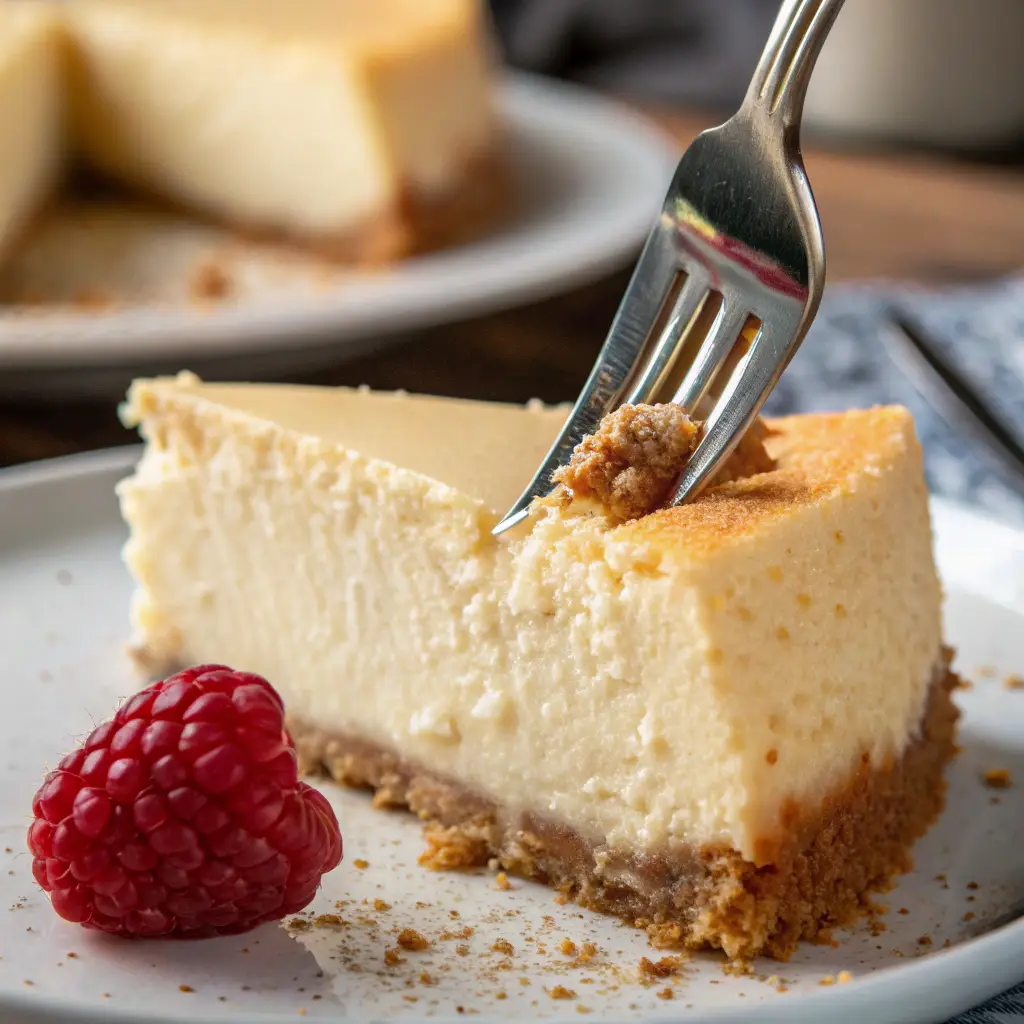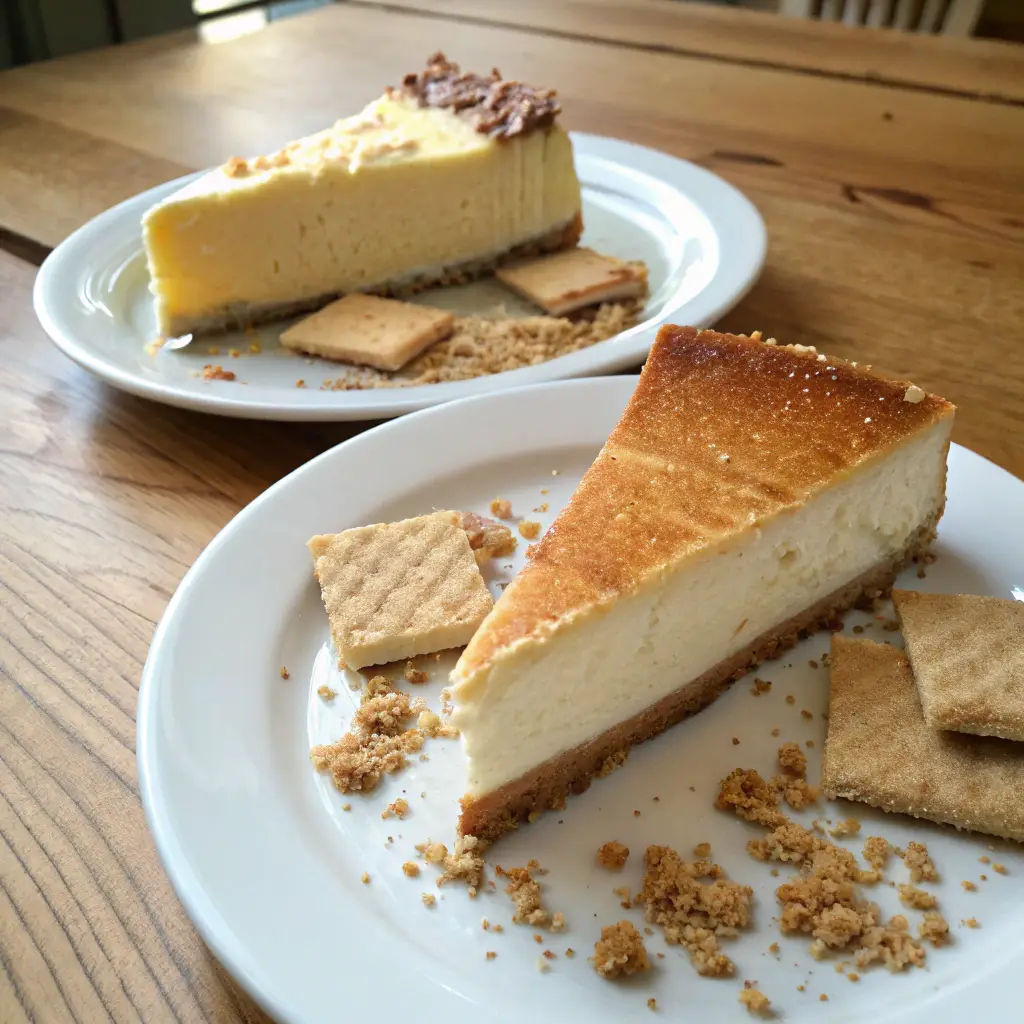Let’s talk about taste of cheesecake. You know, that rich, creamy, slightly tangy dessert that somehow manages to be both decadent and refreshing at the same time? Whether you’re a die-hard fan or someone still trying to figure out what the hype is all about, there’s no denying that cheesecake has a one-of-a-kind flavor.
Some say it’s like eating sweetened cream cheese. Others describe it as a balance of sweet, tangy, and buttery flavors, wrapped up in a smooth, velvety texture. Then, of course, there are the folks who just don’t get it—saying it tastes weirdly sour or even “like spoiled milk” (harsh, right?).
So, what does cheesecake really taste like? Well, that depends on a few things—ingredients, texture, baking style, and even personal preference. In this article, we’re diving deep into the flavors of cheesecake, from classic New York-style to airy Japanese versions. We’ll also break down what makes this dessert so irresistible (or, in some cases, controversial).
Grab a fork (or don’t, if you’re just here for the facts), and let’s dig in!
Table of Contents
Part 1: The Irresistible Allure of Cheesecake
What Makes Cheesecake So Unique?
First things first—cheesecake isn’t really a cake. Yep, you read that right. It’s actually more of a custard or pie, depending on who you ask. Instead of a fluffy, spongy texture like traditional cakes, cheesecake is dense, creamy, and smooth.
The main reason it tastes so different from other desserts? Cream cheese. Unlike most sweets that rely heavily on sugar and flour, cheesecake gets its flavor from a combination of cream cheese, eggs, sugar, and sometimes sour cream or heavy cream. That’s what gives it that sweet-yet-slightly-tangy profile.
Then there’s the crust. Most cheesecakes sit on a buttery, crumbly graham cracker base, which adds a slight crunch and a bit of caramel-like sweetness. Some variations use Oreo crusts, shortbread, or even no crust at all—each affecting the overall flavor in subtle ways.
A Brief History of Cheesecake and Its Evolution in Taste
Cheesecake isn’t new. In fact, it’s ancient. The first recorded cheesecake dates all the way back to Greece, around 2000 BC. Back then, it was made with cheese, honey, and wheat, baked into a simple dessert (far from the creamy goodness we know today).
Fast forward to New York in the 1900s, and cheesecake got its signature flavor—thanks to cream cheese, which became the main ingredient. This shift gave us the classic, rich, dense texture that we now associate with the dessert.
Since then, cheesecakes have evolved in countless ways. From light and airy Japanese cheesecakes to caramelized, almost burnt Basque cheesecakes, every version brings a different spin on that creamy, tangy, and sweet taste.
And let’s not forget the flavors! You’ve got everything from classic vanilla and chocolate to fruity versions like strawberry and lemon, and even wildcards like matcha and pumpkin spice.
At its core, though, cheesecake always has that signature balance—sweet, rich, and just a little tangy. That’s what makes it so addicting (and, for some, a little polarizing).
Cheesecake isn’t new. In fact, it’s ancient. The first recorded cheesecake dates all the way back to Greece, around 2000 BC. Back then, it was made with cheese, honey, and wheat, baked into a simple dessert—far from the creamy goodness we know today. If you’re interested in how cheesecake evolved through history, check out The History of Cheesecake: From Ancient Greece to Today on Cheesecake.com.
Part 2: The Core Flavors of Cheesecake – A Symphony of Sweetness and Tang
The Signature Tanginess: A Balance Between Sweet and Tart

If you’ve ever taken a bite of cheesecake, you know it doesn’t just taste sweet. Unlike typical desserts that rely purely on sugar, cheesecake has a distinct tanginess that sets it apart. This comes from its main ingredient—cream cheese.
Cream cheese has a mildly sour yet rich taste, which blends with sugar to create that classic sweet-and-tangy contrast. Some cheesecakes take it even further by adding sour cream, lemon juice, or yogurt, boosting the tang and making the flavor even more pronounced.
Now, here’s where it gets interesting—different types of cheesecake lean either more tangy or more sweet, depending on the recipe. New York-style cheesecake, for example, has a bold, slightly sour kick, while no-bake cheesecakes tend to be much milder and sweeter because they use gelatin instead of eggs.
That tanginess also plays a role in why some people don’t like cheesecake. For those who expect a dessert to be purely sweet, that slight sourness can be unexpected. But for those who love balance in flavors, it’s what makes cheesecake so addicting.
The Creamy, Velvety Texture That Defines Cheesecake
Of course, it’s not just the taste that makes cheesecake special—it’s also the texture. When made right, cheesecake is smooth, dense, and creamy, almost like a mix between custard and mousse.
That texture comes from a combination of cream cheese, eggs, and heavy cream. When baked, the eggs help create that rich, velvety smooth consistency that melts in your mouth. In contrast, no-bake cheesecakes are often lighter and fluffier, since they don’t go through the heat that firms up the texture.
The texture also changes depending on how long you bake it. If overbaked, a cheesecake can turn dry and grainy. But when done just right, it’s luxuriously creamy with a perfect balance of firmness and softness.
And let’s not forget the crust! The crunchy, buttery graham cracker crust (or sometimes Oreo, shortbread, or even Biscoff) adds a contrasting texture that makes every bite more satisfying.
The Role of Different Cheeses in Flavor Variations
Did you know that not all cheesecakes use cream cheese? Depending on where you are in the world, the type of cheese used can completely change the flavor.
- American-style cheesecake (New York, classic, etc.) → Uses cream cheese, making it rich, smooth, and slightly tangy.
- Italian-style cheesecake → Uses ricotta cheese, giving it a lighter, slightly grainy texture with a mild sweetness.
- French cheesecake → Made with Neufchâtel cheese, making it softer and a bit saltier.
- German cheesecake (Käsekuchen) → Uses quark cheese, which has a stronger tang than cream cheese.
- Japanese cheesecake → Made with a mix of cream cheese and whipped egg whites, making it airy and soufflé-like.
So, while cheesecake always has that signature creamy and tangy taste, the type of cheese used can make a big difference in how it ultimately tastes.
Part 3: Types of Cheesecake and Their Distinctive Tastes
New York-Style Cheesecake: Dense, Creamy, and Slightly Tangy
This is the classic. When people think of cheesecake, they’re probably imagining New York-style cheesecake—thick, rich, and incredibly creamy.
This version is made with lots of cream cheese, eggs, and heavy cream, giving it that dense yet velvety texture. It’s baked at a high temperature first, then slowly cooled, creating a firm yet silky interior.
Flavor-wise, New York cheesecake is bold. It has a noticeable tangy kick from the cream cheese and often includes a hint of vanilla or lemon. It’s not overly sweet, which is why it pairs so well with fruit toppings, chocolate, or caramel sauces.
One of the best things about New York-style cheesecake? It doesn’t need extra toppings to taste amazing. It’s rich enough on its own, making it a true standalone dessert.
Japanese Cheesecake: Light, Airy, and Subtly Sweet
Now, let’s flip the script. While New York-style cheesecake is dense and heavy, Japanese cheesecake is the exact opposite—light, fluffy, and delicate.
This version uses less cream cheese and more eggs, resulting in a texture that’s almost like a soufflé. Instead of being rich and creamy, it’s soft, airy, and jiggly, with a taste that’s less tangy and more subtly sweet.
Because of its delicate texture, Japanese cheesecake is best enjoyed fresh. It has a mild flavor, making it perfect for those who want a cheesecake that’s not too overpowering.
Italian Ricotta Cheesecake: A More Textured, Less Creamy Experience
If you ever try an Italian-style cheesecake, don’t expect the same smooth, creamy bite as New York cheesecake. Instead of cream cheese, this version is made with ricotta cheese, which gives it a slightly grainy texture.
Italian cheesecake is less sweet and more naturally milky, with a mild, almost nutty taste. It’s often flavored with honey, citrus zest, or even a splash of liquor, giving it a unique, almost rustic flavor profile.
Burnt Basque Cheesecake: A Caramelized Twist on the Classic
Ever heard of Burnt Basque cheesecake? This Spanish version has been trending in recent years, and for good reason—it looks totally different from any other cheesecake.
Instead of being smooth and even, Burnt Basque cheesecake is baked at a high temperature until the top is deeply caramelized and cracked. This creates a slightly burnt, smoky flavor that balances out the sweet, creamy interior.
Flavor-wise, it’s less tangy than New York cheesecake but has a deeper, almost caramel-like richness. The outside is toasty, while the inside stays soft and custard-like.
It’s also one of the easiest cheesecakes to make because you don’t need a crust—the caramelized top acts as the perfect flavor booster.
Part 4: What Influences the Taste of Cheesecake?
Cheesecake may seem simple—just a mix of cream cheese, sugar, eggs, and a crust, right? But the truth is, every little ingredient and baking choice changes the flavor in a big way. From the crust to the type of sweetener, even the way it’s baked (or not baked) can completely transform the taste and texture.
Let’s break down the key factors that shape how cheesecake tastes!
How the Crust Impacts the Overall Flavor Profile
Even though cheesecake is all about the creamy filling, the crust plays a huge role in its taste. A good crust isn’t just there for structure—it adds extra layers of flavor and texture.

Here’s how different crusts change the cheesecake experience:
- Graham Cracker Crust – The classic! It’s buttery, slightly sweet, with a mild caramelized flavor that pairs perfectly with the tangy cheesecake filling.
- Oreo Crust – Rich and chocolaty, this crust makes cheesecakes taste sweeter and more dessert-like, perfect for chocolate lovers.
- Shortbread Crust – A delicate, buttery, and slightly crisp crust that adds a subtle sweetness without overpowering the cheesecake.
- Almond or Nut-Based Crust – Gives a nutty depth to the cheesecake, making it slightly richer and more complex.
- No Crust at All – Some cheesecakes skip the crust, focusing entirely on the pure, creamy filling. This makes the tanginess and richness even more pronounced.
A sweet and buttery crust can tone down the tanginess of the filling, while a darker, more roasted crust (like an Oreo or burnt Basque crust) adds deeper, caramelized notes.
Sweeteners and Their Effect on Cheesecake’s Taste
You might think all cheesecakes use plain white sugar, but that’s not always the case! The type of sweetener used can make a big difference in flavor:
- White Sugar – The go-to choice. It provides a clean, straightforward sweetness without changing the classic cheesecake flavor.
- Brown Sugar – Adds a hint of molasses, creating a richer, slightly caramel-like taste.
- Honey or Maple Syrup – Infuses the cheesecake with natural, floral, or woody undertones. This works great for lighter cheesecakes, like ricotta or no-bake versions.
- Sweetened Condensed Milk – Often used in Filipino-style cheesecakes, this makes the cheesecake extra creamy and sweet, with a subtle milky caramel flavor.
- Alternative Sweeteners (Stevia, Monk Fruit, etc.) – Used in sugar-free cheesecakes, but they sometimes give a slightly artificial aftertaste.
If you love classic, tangy cheesecake, white sugar is the way to go. But if you prefer deeper, richer flavors, brown sugar or honey can add extra complexity.
Baking vs. No-Bake: How Cooking Methods Change the Flavor
Not all cheesecakes go in the oven! And whether they’re baked or chilled makes a huge impact on their taste and texture.
Baked Cheesecake: Rich, Dense, and Velvety
A baked cheesecake is silky, dense, and ultra-creamy, with a slightly firmer texture. The eggs in the mixture help create a custard-like consistency, which makes it heavier and richer.
Key taste differences:
✔ Has a deeper, slightly caramelized flavor (thanks to slow baking).
✔ The tangy notes are more balanced with the creamy texture.
✔ Can be slightly nutty or toasty, especially if the top gets golden brown.
No-Bake Cheesecake: Light, Fluffy, and Milder in Flavor
A no-bake cheesecake skips the oven and firms up in the fridge, using gelatin or whipped cream to hold its shape. Since it isn’t exposed to heat, it has a lighter, silkier, and more mousse-like texture.
Key taste differences:
✔ Sweeter and less tangy (since baking enhances the sourness of the cream cheese).
✔ Has a fresher, milkier flavor without any caramelized notes.
✔ Tastes more like a creamy, chilled dessert than a dense cake.
So, if you love bold, rich flavors, a baked cheesecake is your best bet. But if you prefer light and sweet, a no-bake version might be more your style!
While baked cheesecakes have that signature rich and velvety texture, no-bake cheesecakes are often lighter and creamier. But are they just as good? If you’re wondering whether no-bake cheesecakes live up to the hype, check out this detailed breakdown: Are No-Bake Cheesecakes Any Good?. It dives into the pros and cons of no-bake cheesecakes, helping you decide if they’re worth a try!
FAQs
Why does cheesecake taste sour?
Cheesecake has a slight tangy flavor because of cream cheese, which has a natural acidity. Some recipes also include sour cream, Greek yogurt, or lemon juice, which enhance that tartness. However, a properly balanced cheesecake should taste more sweet than sour, with just a hint of tanginess.
What is the best way to describe the taste of cheesecake?
Cheesecake is creamy, rich, and slightly tangy, with a velvety texture that melts in your mouth. The crust (usually graham cracker) adds a buttery, crumbly contrast, making it the perfect balance of sweet, tangy, and smooth. Some variations are more dense and bold, while others are light and airy.
Does all cheesecake taste the same?
Not at all! Different types of cheesecake have distinct flavors. New York cheesecake is dense and tangy, while Japanese cheesecake is light, fluffy, and mildly sweet. Italian-style cheesecake (made with ricotta) has a grainier texture, while Burnt Basque cheesecake has a deep, caramelized flavor.
What makes cheesecake different from other desserts?
Unlike regular cakes, cheesecake has no flour in the filling. Instead, it’s made with cream cheese, eggs, and sugar, giving it a custard-like texture. Unlike mousse or pudding, it’s firmer and more structured, yet still melts in your mouth. Plus, it has that signature tanginess that sets it apart!
Conclusion
Cheesecake isn’t just a dessert—it’s a flavor experience. With its creamy, rich texture and perfect balance of sweet and tangy flavors, it’s no surprise that it has remained a favorite for centuries. Whether it’s the dense, indulgent bite of a New York cheesecake, the light and airy texture of a Japanese version, or the caramelized goodness of a Burnt Basque cheesecake, there’s a style for everyone.
What makes cheesecake truly special is its versatility. It can be baked or no-bake, simple or topped with fruit, chocolate, or caramel. Even the crust changes the game—whether it’s a classic graham cracker base, Oreo crust, or even a nutty almond layer.
At its core, cheesecake is comforting yet elegant, simple yet sophisticated. It’s the kind of dessert that brings people together—served at birthdays, celebrations, and holidays. And with so many variations, you could try a different type of cheesecake every month and never get bored!
So, the next time you take a bite of cheesecake, pay attention to its flavors, textures, and history. Because no matter how you slice it, cheesecake is a true classic that never goes out of style. 🍰

